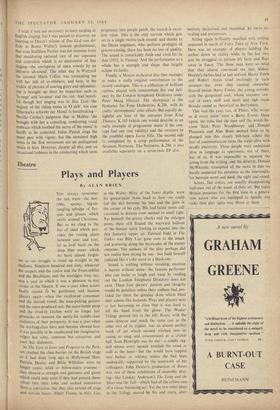Records
Celebrated Ladies
By DAVID CAIRNS'
IN The Art of the Prima Donna (Decca, two discs, each available separ- ately) Joan Sutherland pays homage to the divas of the last 150 years who are the familiar spirits of her world. Sixteen operatic arias, with the Covent Garden Orchestra conducted by Molinari-Pradelli, take us round the gallery of bel canto from Arne's Artaxerxes to Laknze. Each aria is attended on the sleeve by the name, and dates, of a famous soprano with whom it has at some time been 'associated': thus the Waltz Song from Gounod's Romeo and Juliet suggests Patti, Ophelia's Mad Scene from Thomas's hamlet recalls Melba, Vasta Diva' brings to mind Giuditta Pasta, 'Martern aller Arten' Lilli Lehmann, and so on. We read that 'in a period where "style" is too often forgotten, Miss Sutherland's particular interest in stylistic accuracy, as well as her great respect for the worthy traditions of the vocal art, merited this showcase.'
I could say something about the traditions of the vocal art and what they have done to the art of opera, but I will refrain. The age is past when composers were sacrificed alive on the egos of singers and operas fed like sweetmeats into the fashionable beaks of greedy nightingales. But though Miss Sutherland's invocation of the ancient divas is a pardonable conceit, it is a perilous one. The Art of the Prim; a Donna dis- claims any wish to 're-create or imitate the accomplishments of these celebrated ladies'; but the pattern of this recital makes it a touchstone by which her limitations are inevitably revealed.
Simply as sound—radiant, dreamy, nobly elegiac--these are dazzling records. Her colora- tura (in an aria from Rossini's Semiramide, for example) may not have quite the arrogant case and charming naturalness of Tetrazzini's; but the beauty and purity of Miss Sutherland's high notes alone would have made her a phenomenon in any age. Yet again and again I miss, even in the sound, the urgent, indefinable element, the life-force, that begets a great singer. Where music demands from the artist passion, fire, depth of feeling, she can only go on singing; the notes do not speak--to me, at least. Compared with Ponselle's, her 'Casta Diva,' performed though it is with exquisite skill, is sheer vocalise. Compared with Galli-Curci's, her 'Caro Nome' is a careful studio reconstruction of ecstasy. The variety of vocal colour on these records does not disguise the monotony of a severely restricted dramatic mood. Her Jewel Song from Faust has grace, elegance, a mastery of trill and flowing line; but, like the `Sempre libera' in her 7'raviata, D. shows her incapable as yet of true vivacity. In the last resort nearly all the arias on these records come to mean practically the same thing. The marvellous voice itself ends by being boring. 'Style,' after all, even with the most glittering natural gifts and a technique to go with them, may take you so far but no farther.
Of the two records, Volume 1 has the attrac- tion of four excerpts from her favourite Bellini, but the Samson and Artaxerxes numbers suffer from strangely tentative coloratura, and I prefer Volume 2, which includes some Verdi, a fine `Martern aller Arten,' the Ophelia scene, and the Bell Song from Lakme. Miss Sutherland is brilliant in Lakme; but I hope she will not rest content with that level of musical and dramatic accomplishment.
The Art of Elizabeth Rethberg, the latest issue in the admirable Camden series, supplies the quality that I miss still in Miss Sutherland—a native intensity in the voice, instantly raising opera to the heightened plane of existence where it belongs. Take the Jewel Song; Madame Reth- berg is not ideal in it, but her singing has an inherent vitality which makes fundamental sense of the piece as Miss Sutherland's does not. It is a pity that Aida, one of her greatest parts, is not represented here—the duet with Amonasro (de Luca) in Act 3 was, one would have thought, an automatic choice for such a collection. None the less, this is an indispensable record, with arias from Fledermaus, Faust, Ballo in Maschera, Otello, II Re Pastore, Boccaccio (Suppe) and The Flying Dutchman. The voice is thrilling in its fiery purity and concentration, the style noble and sincere, and the recordings, transferred from pre-war 78s, leave surprisingly little to be desired.
Another satisfying vocal disc is the collection of Purcell songs sung by the American counter- tenor Russell Oberlin and issued by the World Record Club (price 26s. 3d.). Mr. Oberlin is announced as Oberon in A Midsummer Night's Dream at Covent Garden next month. If he ful- fils the promise of this remarkable record, fancy we shall hear less about Britten's 'mis- calculation' in composing the part for counter- tenor. After the gentility of the prevailing English fashion, it is an infinite relief to hear Purcell's virile melodies treated with a matching robust- ness; the indignities habitually practised on our greatest composer in the name of authenticity make one of the saddest ironies of that tragi- comedy which is the English musical establish- ment. Mr. Oberlin does not appear to be a falsettist (or cock alto, as the nice phrase in use in the profession has it). Far from sounding dis- embodied and instrumental, his voice has a vigorous personal tang. The timbre is clear and brilliant and instinct with a kind of austere sensuousness, and the effect is, paradoxically. of such essential virility that one can hear him declaim 'He to Celia steals and by pleasures unconfin'd runs o'er the night' without the smallest qualm of disbelief. Among other songs, none of which is not a masterpiece, I must single out 'I love and 1 must' and that sublime Evening Hymn on a ground bass. 'Now that the Sun hath veil'd his light.' I wish it was not necessary to keep carping at English singing, but I was pained to discover, on listening to Decca's reissue of Das Lied von der Erde in Bruno Walter's famous performance, that even Kathleen Ferrier was not immune from that maddening national vice of our sopranos and contraltos which is so destructive of fine singing—the corruption of open -vowels by an Intrusive uh-sound. The other day in Wozzeck the talented Marie Collier was tormenting me With her talk of so-uhldiers; and here, in the middle of phrases of soaring glory and splendour. one is brought up short by impurities such as 'la-unge' and `so-unne' and the rest. And beauti- ful though her singing was in Das Lied—the majesty of the riding moon in '0 sich', wie eine Silberbarke schwebt der Mond' is breathtaking— Neville Cardus's judgment that in Mahler 'she brought with her a consoling, comforting vocal embrace which soothed the nerve of the music' is hardly to be contested. Julius Patzak sings the tenor part with vigour, but the sustained high notes in the first movement are an undisguised strain to him. However, despite all this, and an occasional lushness in the conducting which turns poignancy into purple patch, the record is excel- lent value. This is the only version which gets on to a single twelve-inch record; and thanks to the Dccca engineers, who perform prodigies of groove-cutting, there has been no loss of quality. The sound is remarkably fresh and vivid for its date (1952, in Vienna). And the performance as a whole has a strength and shape that largely eclipse its faults.
Finally, a Mozart orchestral disc that manages to make a really original contribution to the record catalogue. This is a collection of brilliant rarities, played with consummate fire and deli- cacy by the London Symphony Orchestra under Peter Maag (Decca). The showpiece is the Notturno for Four Orchestras, K.286, with its crafty 'stereophonic' echo effects. But equally de- lightful arc four of the entractes from King Thamos, K.345 (which one would describe as an early example of programme music if the con- cept had any real validity) and the overture to the youthful opera Lucia Sub. The second side is completed by a crisp performance of the Sercnata Notturna. The Notturno, K.286, is also available separately on a seven-inch EP disc.



































 Previous page
Previous page